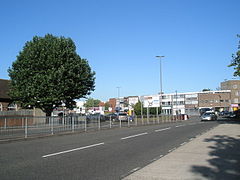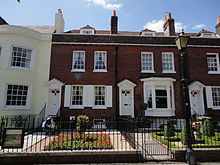
Portsmouth is a port city and unitary authority in Hampshire, England. Most of Portsmouth is located on Portsea Island, off the south coast of England in the Solent. This means Portsmouth is the only English city not located primarily on the mainland. Located 74 miles (119 km) south-west of London, 50 miles (80 km) west of Brighton and Hove, and 22 miles (35 km) south-east of Southampton; Portsmouth is part of the South Hampshire conurbation. It is the most densely populated city in the United Kingdom, with a population last recorded at 208,100.

Southsea is a seaside resort and a geographic area of Portsmouth, Portsea Island in England. Southsea is located 1.8 miles (2.8 km) to the south of Portsmouth's inner city-centre. Southsea is not a separate town as all of Portsea Island's settlements were incorporated into the boundaries of Portsmouth in 1904.


The fortifications of Portsmouth are extensive due to its strategic position on the English Channel and role as home to the Royal Navy. For this reason, Portsmouth was, by the 19th century, one of the most fortified cities in the world. The fortifications have evolved over the centuries in response to changes in tactics and technology and the area defended has increased. While the first defences focused on Portsmouth harbour, in step with the fortifications of Gosport, later defensive structures protected the whole of Portsea Island and an increasing distance inland. At the same time, the fortifications of Portsmouth and Gosport became part of the wider fortifications of the Solent. Old Portsmouth, on the southwest corner of Portsea Island, has been walled for much of its history.

Portsea Island is a flat and low-lying natural island 24.5 square kilometres in area, just off the southern coast of Hampshire in England. Portsea Island contains the majority of the city of Portsmouth.
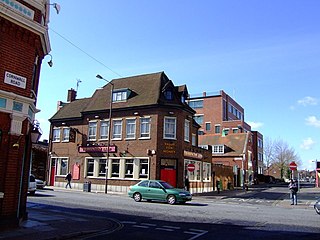
Fratton is a residential and formerly industrial area of Portsmouth in Hampshire, England. Victorian style terraced houses are dominant in the area, typical of most residential areas of Portsmouth. Fratton has many discount shops and "greasy spoon" cafes, as well as the Bridge Centre shopping centre containing an Asda.
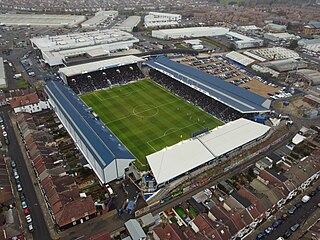
Fratton Park is a football ground in Portsmouth, England and is the home of Portsmouth F.C.. Fratton Park's location on Portsea Island is unique in English professional football, as it is the only professional English football ground not found on the mainland of Great Britain. Fratton Park has been the only home football ground in Portsmouth FC's entire history.
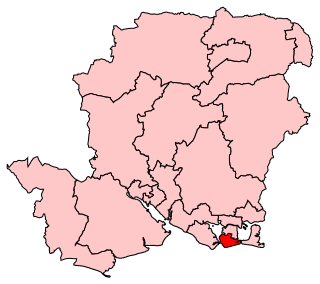
Portsmouth South is a constituency represented in the House of Commons of the UK Parliament since 2017 by Stephen Morgan of the Labour Party. Morgan is the first Labour MP to represent the seat.

The Southsea Railway was a short railway branch line. It was built to give easier access from the jointly operated main line railway approaching Portsmouth to the Clarence Pier from which Isle of Wight ferries sailed. In 1879 the extension of the main line railway to Portsmouth Harbour station, where direct transfer from train to steamer was possible, eliminated most of the steamer business at Clarence Pier. Undeterred, promoters interested in developing Southsea projected the Southsea Railway, connecting a new Fratton station on the main line, with Southsea. The line was opened on 1 July 1885. Its independent promoters believed that it could be a main line terminus for London trains, and they constructed the line lavishly in consequence.

Portsmouth & Southsea railway station is a Grade II listed building and the main railway station in the city of Portsmouth in Hampshire, England. It is in the Landport area close to the Commercial Road shopping area. British Transport Police maintain a presence at the station. There is a taxi rank at the front of the building and regular local buses within five minutes' walking distance.

Stamshaw is a residential district of Portsmouth, located on the north western corner of Portsea Island in southern England.

Copnor is an area of Portsmouth, England, located on the eastern side of Portsea Island. The population of Copnor Ward at the 2011 Census was 13,608. As Copenore, it was one of the three villages listed as being on Portsea Island in the Domesday book.
Milton is a residential area of the English city of Portsmouth, Hampshire, England, on the south eastern side of Portsea Island. Milton is bordered on the eastern coast of Portsea Island by Langstone Harbour, with Eastney to the south-east, Southsea to the south-west, Baffins to the north and Fratton to the north-west.
Kingston is a residential area of the city of Portsmouth in the English county of Hampshire, lying between Buckland, Fratton, Milton and North End. It was a recognised suburb of the city by the middle of the 19th century.

King James's and Landport Gates are two English Heritage gateways in Portsmouth, Hampshire, England.
Portsmouth West was a borough constituency in the city of Portsmouth in Hampshire, England. It returned one Member of Parliament (MP) to the House of Commons of the Parliament of the United Kingdom, elected by the first-past-the-post voting system.
Buckland is a residential area in the city of Portsmouth in the English county of Hampshire.
